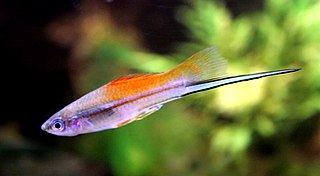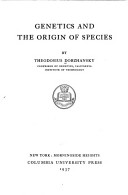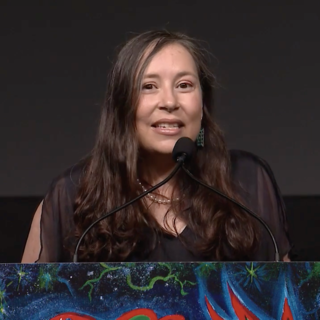Related Research Articles
Microevolution is the change in allele frequencies that occurs over time within a population. This change is due to four different processes: mutation, selection, gene flow and genetic drift. This change happens over a relatively short amount of time compared to the changes termed macroevolution.
Speciation is the evolutionary process by which populations evolve to become distinct species. The biologist Orator F. Cook coined the term in 1906 for cladogenesis, the splitting of lineages, as opposed to anagenesis, phyletic evolution within lineages. Charles Darwin was the first to describe the role of natural selection in speciation in his 1859 book On the Origin of Species. He also identified sexual selection as a likely mechanism, but found it problematic.

Theodosius Grigorievich Dobzhansky was a prominent Ukrainian and American geneticist and evolutionary biologist. He was a central figure in the field of evolutionary biology for his work in shaping the modern synthesis. Born in the Russian Empire, Dobzhansky emigrated to the United States in 1927, aged 27.

The modern synthesis was the early 20th-century synthesis of Charles Darwin's theory of evolution and Gregor Mendel's ideas on heredity into a joint mathematical framework. Julian Huxley coined the term in his 1942 book, Evolution: The Modern Synthesis. The synthesis combined the ideas of natural selection, Mendelian genetics, and population genetics. It also related the broad-scale macroevolution seen by palaeontologists to the small-scale microevolution of local populations.
Allopatric speciation – also referred to as geographic speciation, vicariant speciation, or its earlier name the dumbbell model – is a mode of speciation that occurs when biological populations become geographically isolated from each other to an extent that prevents or interferes with gene flow.

Evolutionary biology is the subfield of biology that studies the evolutionary processes that produced the diversity of life on Earth. It is also defined as the study of the history of life forms on Earth. Evolution holds that all species are related and gradually change over generations. In a population, the genetic variations affect the phenotypes of an organism. These changes in the phenotypes will be an advantage to some organisms, which will then be passed onto their offspring. Some examples of evolution in species over many generations are the peppered moth and flightless birds. In the 1930s, the discipline of evolutionary biology emerged through what Julian Huxley called the modern synthesis of understanding, from previously unrelated fields of biological research, such as genetics and ecology, systematics, and paleontology.

Xiphophorus is a genus of euryhaline and freshwater fishes in the family Poeciliidae of order Cyprinodontiformes, native to Mexico and northern Central America. The many Xiphophorus species are all known as platyfish and swordtails. Platyfish formerly were classified in another genus, Platypoecilia, which is now obsolete. The type species is X. hellerii, the green swordtail. Like most other new world Poeciliids, platies and swordtails are live-bearers that use internal fertilization and give birth to live young instead of laying eggs like the bulk of the world's fishes. The name Xiphophorus derives from the Greek words ξίφος (dagger) and φόρος (bearer), referring to the gonopodium on the males. All are relatively small fishes, which reach a maximum length of 3.5–16 cm (1.4–6.3 in) depending on the exact species involved.

"Nothing in Biology Makes Sense Except in the Light of Evolution" is a 1973 essay by the evolutionary biologist Theodosius Dobzhansky, criticising anti-evolution creationism and espousing theistic evolution. The essay was first published in American Biology Teacher in 1973.

Genetics and the Origin of Species is a 1937 book by the Ukrainian-American evolutionary biologist Theodosius Dobzhansky. It is regarded as one of the most important works of modern synthesis and was one of the earliest. The book popularized the work of population genetics to other biologists and influenced their appreciation for the genetic basis of evolution. In his book, Dobzhansky applied the theoretical work of Sewall Wright (1889–1988) to the study of natural populations, allowing him to address evolutionary problems in a novel way during his time. Dobzhansky implements theories of mutation, natural selection, and speciation throughout his book to explain the habits of populations and the resulting effects on their genetic behavior. The book explains evolution in depth as a process over time that accounts for the diversity of all life on Earth. The study of evolution was present, but greatly neglected at the time. Dobzhansky illustrates that evolution regarding the origin and nature of species during this time in history was deemed mysterious, but had expanding potential for progress to be made in its field.

Hybrid speciation is a form of speciation where hybridization between two different species leads to a new species, reproductively isolated from the parent species. Previously, reproductive isolation between two species and their parents was thought to be particularly difficult to achieve, and thus hybrid species were thought to be very rare. With DNA analysis becoming more accessible in the 1990s, hybrid speciation has been shown to be a somewhat common phenomenon, particularly in plants. In botanical nomenclature, a hybrid species is also called a nothospecies. Hybrid species are by their nature polyphyletic.
H. Allen Orr is the Shirley Cox Kearns Professor of Biology at the University of Rochester.
Daven Presgraves is University Dean's Professor in the Department of Biology at the University of Rochester.

The Bateson–Dobzhansky–Muller model, also known as Dobzhansky–Muller model, is a model of the evolution of genetic incompatibility, important in understanding the evolution of reproductive isolation during speciation and the role of natural selection in bringing it about. The theory was first described by William Bateson in 1909, then independently described by Theodosius Dobzhansky in 1934, and later elaborated in different forms by Herman Muller, H. Allen Orr and Sergey Gavrilets.

Reinforcement is a process of speciation where natural selection increases the reproductive isolation between two populations of species. This occurs as a result of selection acting against the production of hybrid individuals of low fitness. The idea was originally developed by Alfred Russel Wallace and is sometimes referred to as the Wallace effect. The modern concept of reinforcement originates from Theodosius Dobzhansky. He envisioned a species separated allopatrically, where during secondary contact the two populations mate, producing hybrids with lower fitness. Natural selection results from the hybrid's inability to produce viable offspring; thus members of one species who do not mate with members of the other have greater reproductive success. This favors the evolution of greater prezygotic isolation. Reinforcement is one of the few cases in which selection can favor an increase in prezygotic isolation, influencing the process of speciation directly. This aspect has been particularly appealing among evolutionary biologists.

The Daphne Major finches are a group of Darwin's finches that inhabit Daphne Major island of the Galápagos. The common cactus finch and the medium ground finch are the main species; while the large ground finch and the Española cactus finch are regular immigrants. Most extensively studied by Peter and Rosemary Grant of Princeton University since 1973, the birds are one of the sources of the understanding of bird behaviour, adaptation, and evolution.

The scientific study of speciation — how species evolve to become new species — began around the time of Charles Darwin in the middle of the 19th century. Many naturalists at the time recognized the relationship between biogeography and the evolution of species. The 20th century saw the growth of the field of speciation, with major contributors such as Ernst Mayr researching and documenting species' geographic patterns and relationships. The field grew in prominence with the modern evolutionary synthesis in the early part of that century. Since then, research on speciation has expanded immensely.

Adriana Darielle Mejía Briscoe is an American evolutionary biologist and Professor of Ecology and Evolutionary Biology at the School of Biological Sciences at the University of California, Irvine. She specializes in research questions at the intersection of sensory physiology, color vision, coloration, animal behavior, molecular evolution, and genomics.
Paul S. Mischel is an American physician-scientist whose laboratory has made pioneering discoveries in the pathogenesis of human cancer. He is currently a Professor and Vice Chair of Research for the Department of Pathology and Institute Scholar of ChEM-H, Stanford University. Mischel was elected into the American Society for Clinical Investigation (ASCI), serving as ASCI president in 2010/11. He was inducted into the Association of American Physicians, and was elected as a fellow of the American Association for the Advancement of Science.
Hybrid incompatibility is a phenomenon in plants and animals, wherein offspring produced by the mating of two different species or populations have reduced viability and/or are less able to reproduce. Examples of hybrids include mules and ligers from the animal world, and subspecies of the Asian rice crop Oryza sativa from the plant world. Multiple models have been developed to explain this phenomenon. Recent research suggests that the source of this incompatibility is largely genetic, as combinations of genes and alleles prove lethal to the hybrid organism. Incompatibility is not solely influenced by genetics, however, and can be affected by environmental factors such as temperature. The genetic underpinnings of hybrid incompatibility may provide insight into factors responsible for evolutionary divergence between species.
Eukaryote hybrid genomes result from interspecific hybridization, where closely related species mate and produce offspring with admixed genomes. The advent of large-scale genomic sequencing has shown that hybridization is common, and that it may represent an important source of novel variation. Although most interspecific hybrids are sterile or less fit than their parents, some may survive and reproduce, enabling the transfer of adaptive variants across the species boundary, and even result in the formation of novel evolutionary lineages. There are two main variants of hybrid species genomes: allopolyploid, which have one full chromosome set from each parent species, and homoploid, which are a mosaic of the parent species genomes with no increase in chromosome number.
References
- ↑ "Molly Schumer's Profile | Stanford Profiles". profiles.stanford.edu. Retrieved 2021-01-11.
- ↑ University, © Stanford; Stanford; California 94305 (2019-09-10). "Molly Schumer - Assistant Professor of Biology". Welcome to Bio-X. Retrieved 2021-01-11.
{{cite web}}: CS1 maint: numeric names: authors list (link) - 1 2 "HHMI Selects 15 Hanna Gray Fellows to Support Diversity in Science". HHMI.org. Retrieved 2021-01-11.
- ↑ "REED COLLEGE Renn lab members". www.reed.edu. Retrieved 2021-01-11.
- ↑ alan. "Alumni News from Reed Magazine, June '11 | Chemistry News" . Retrieved 2021-01-11.
- ↑ ORCID. "Molly Schumer (0000-0002-2075-5668)". orcid.org. Retrieved 2021-01-11.
- 1 2 "Hybrids, Hybrids Everywhere". hms.harvard.edu. Retrieved 2021-01-11.
- 1 2 "Dobzhansky Prize". www.evolutionsociety.org. Retrieved 2021-01-11.
- ↑ "Publications". Schumer lab. 2018-01-12. Retrieved 2021-01-24.
- ↑ "Molly Schumer". scholar.google.com. Retrieved 2021-01-24.
- ↑ Schumer, Molly; Rosenthal, Gil G.; Andolfatto, Peter (2014-04-13). "How Common is Homoploid Hybrid Speciation?". Evolution. 68 (6): 1553–1560. doi:10.1111/evo.12399. ISSN 0014-3820. PMID 24620775.
- ↑ Zhen, Y.; Aardema, M. L.; Medina, E. M.; Schumer, M.; Andolfatto, P. (2012-09-28). "Parallel Molecular Evolution in an Herbivore Community". Science. 337 (6102): 1634–1637. doi:10.1126/science.1226630. ISSN 0036-8075. PMC 3770729 . PMID 23019645.
- ↑ Cui, Rongfeng; Schumer, Molly; Kruesi, Karla; Walter, Ronald; Andolfatto, Peter; Rosenthal, Gil G. (2013-04-04). "Phylogenomics Reveals Extensive Reticulate Evolution Inxiphophorusfishes". Evolution. 67 (8): 2166–2179. doi:10.1111/evo.12099. ISSN 0014-3820. PMID 23888843.
- ↑ Schumer, Molly; Xu, Chenling; Powell, Daniel L.; Durvasula, Arun; Skov, Laurits; Holland, Chris; Sankararaman, Sriram; Andolfatto, Peter; Rosenthal, Gil G. (2017-11-01). "Natural selection interacts with the local recombination rate to shape the evolution of hybrid genomes". doi:10.1101/212407. S2CID 89742595 . Retrieved 2021-01-24.
{{cite journal}}: Cite journal requires|journal=(help) - ↑ Spengler, Mary L.; Kuropatwinski, Karen K.; Schumer, Molly; Antoch, Marina (2009-12-15). "A serine cluster mediates BMAL1-dependent CLOCK phosphorylation and degradation". Cell Cycle. 8 (24): 4138–4146. doi: 10.4161/cc.8.24.10273 . ISSN 1538-4101. PMC 4073639 . PMID 19946213.
- ↑ "2019 Rosalind Franklin Young Investigator Award Winners Announced". Genes to Genomes. 2019-10-10. Retrieved 2021-01-11.
- ↑ "EEB Annual Atwood Colloquium". Ecology & Evolutionary Biology. Retrieved 2021-01-11.
- ↑ Schumer, Molly; Rosenthal, Gil G.; Andolfatto, Peter (April 2018). "What do we mean when we talk about hybrid speciation?". Heredity. 120 (4): 379–382. doi:10.1038/s41437-017-0036-z. ISSN 0018-067X. PMC 5842215 . PMID 29302049.
- ↑ "Awards & Recognition: November 2017". hms.harvard.edu. Retrieved 2021-01-11.
- ↑ "Five Female Biologists, Engineers and Physicists Receive L'Oréal Fellowships | American Association for the Advancement of Science". www.aaas.org. Retrieved 2021-01-11.
- ↑ "Four Graduate Students Receive PEI Walbridge Fund Awards". High Meadows Environmental Institute. Retrieved 2021-01-11.
- ↑ "2007 Scholars List | Barry Goldwater". goldwater.scholarsapply.org. Retrieved 2021-01-11.